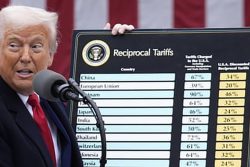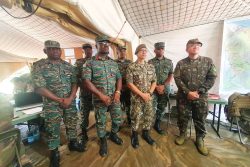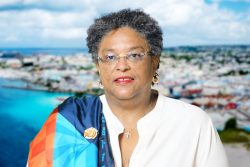Is the Caribbean nothing more than a geographical expression?
The word ‘Caribbean’ conjures diverse meanings. Caribbean cuisine, Caribbean rum and Caribbean vacation are expressions that may be recognised instantly anywhere in the world. Equally diverse are the sources of the word’s emergence and the purpose of its use. In order to achieve a standard definition of the Caribbean that is widely accepted and understood, a range of relevant factors – cultural, economic, geographical, historical, political, social and strategic background – of the area must be considered. An examination of all these factors will help to show why it is difficult but desirable to arrive at a comprehensive concept and an agreed definition of the Caribbean.

The loose use of various expressions with their different meanings over the years has been confusing. In reviewing a number of books on the Caribbean, Aaron Segal identified, as the first weakness of authors and editors, their “failure to provide a consistent and defensible geographic definition of the Caribbean”. In fact, in only six books under review, he found four definitions.
He cited, as his first example, the ‘Caribbean Basin’ that includes Central America, Panama, Mexico, Colombia and Venezuela but excludes the USA. He wrote that, among the 30 countries in the Basin, “…there was little in common except a Caribbean shoreline.” Second, the term ‘Caribbean Islands’ includes the islands of the Caribbean Sea. Third, the concept of the ‘Caribbean Culture Area’ includes the Caribbean Islands, Belize, Guyana, Suriname and Guyane (French Guiana). Finally, the ‘Core Caribbean’ consists of the Commonwealth countries.
Segal acknowledges the difficulty in having to decide whether to rely on geography, culture, history, language or other criteria to define such a fragmented region. Equally, he feels that failure to provide criteria “leads to confusion, misunderstanding and distortion.”
The Historical Caribbean
The Caribbean islands were the first European acquisitions in this hemisphere. At the time of the Spanish irruption they were already inhabited by indigenous peoples – mainly the Arawak (including the Borequino, Lucayano and Taino) and the Carib. Spanish suzerainty remained unchallenged throughout the 16th century during which the Amerindian population was nearly exterminated. The Dutch, English and French started to penetrate the area in the early years of the 17th century. Danish and Swedish settlers followed.
The plantation system which European colonisation spawned was based initially on various forms of forced labour – encomienda, enslavement or indentureship – first of Amerindians and, later, of peoples from Europe, Africa and Asia. Each group brought its own customs and culture. This gave rise to the concept of the ‘creolisation’ which signifies a phemonenon (whether of birth, culture, food or speech) that combines elements inherited from the ‘Old World’ but given new meaning in the ‘New World’ of which the Caribbean was the crucible.
Christopher Columbus’s maritime expedition established regular contact between Europe and America. Simultaneously, various names came to be used to refer to the territories based, first of all, on the mistaken Spanish notion that they had reached India.
The Indies was the term used by the Spanish to describe the territories at which they arrived and which they acquired by going west from Europe. To emphasise their different position relative to the territories that the Portuguese seized in the east which were called the “East Indies,” the new acquisitions came to be called the “West Indies.” The expression is now employed almost exclusively to refer to British, and former British, possessions in the Caribbean Islands and in the north coast of South and Central America − for example, the University of the West Indies or the West Indies Cricket Team.
The “Antilles” is an expression that dates traditionally from before the European entry into the New World. The ‘Antilles’ referred to semi-mythical lands located somewhere West of Europe across the Atlantic. After Columbus’s arrival, the Spanish term ‘Las Antillas’ (French ‘Les Antilles’) was commonly assigned to the new lands. The expression is now employed to describe all of the West Indian islands except the Bahamas. They are divided into two major groups − the Greater Antilles which include Cuba, Hispaniola, Jamaica and Puerto Rico and the Lesser Antilles which include the rest of the islands.
The word “Caribbean” is derived from the name of the supposedly aggressive tribe of Amerindians who were called ‘Caribes’ and were equated by Columbus, mistakenly, to ‘cannibales’. This term was understood by Oveido (1555) to mean ‘brave and daring’ and again was used to describe one of the native races which occupied the southern islands of the West Indies. The term is used loosely today to refer to the islands, sea, states on the American mainland and diverse political, economic and cultural areas.
The Geopolitical Caribbean
The Caribbean is a sub-region of the Western Hemisphere, located largely on the ‘Caribbean Plate.’ At its simplest, the sub-region is a chain of islands surrounding the Caribbean Sea. That sea is approximately 2,640,000 km² in extent and contains over 7,000 cays, islands, islets and reefs.
Within a century of the Spanish conquest, the clash of warlike Western European powers, particularly the Dutch, English and French, transformed the Caribbean into the ‘cockpit of Europe.’ Interstate conflicts in Europe frequently triggered intercolonial ‘cockfights.’ This led, inevitably, to the seizure, surrender or swapping of territories which had strategic value mainly because of their perceived economic value.
The decline of the sugar industry in the 19th century coincided with the rise of the United States as the leading hemispheric power. The American-Spanish war, the acquisition of naval bases, the purchase of the Virgin Islands and the penetration of US capital exemplified the era of the USA’s hegemony and revived the area’s strategic importance throughout the 20th century.
As Harold Mitchell observed, “Located at the approaches to the heart of the Western Hemisphere, the Antilles command the sea routes and Cuba is less than 100 miles from Florida.” In the earlier part of the last century, the Panama Canal added to the importance of this region and, even in recent memory, the USA still found it necessary to invade the Dominican Republic in 1965; Grenada in 1983 and Panama in 1989. It also intervened militarily in Nicaragua in the 1980s in pursuit of its strategic objectives.
Andrés Serbin suggests that the expression ‘Caribbean Basin’ was employed within the context of the Cold War. The United States’ responses to Cuban revolution, the decolonisation of the Anglophone territories and the Central American crises were gave rise to the formulation of the Caribbean Basin Initiative. This definition, like the initiative itself, emphasised the military-strategic perception of the Caribbean as a potential arena of conflict.
At the Western and Eastern extremities of the Caribbean are located two of the most strategically important aerospace centres on earth – the United States centre at Cape Canaveral, Florida and the European space centre at Kourou in Guyane. Despite the end of the Cold War, the North Atlantic allies – France, The Netherlands, the UK and the USA – continued to maintain possessions in the area which is regarded as the Alliance’s vulnerable southern flank.
During the second half of the last century, two great efforts were made to integrate the Anglophone Caribbean. The first was the creation of the political proto-state called the West Indies Federation in 1958. The second was the establishment of the economic entity called the Caribbean Community which succeeded the Caribbean Free Trade Area in 1973. In addition, the Organisation of Eastern Caribbean States that comprises the Commonwealth states of the Lesser Antilles and the Association of Caribbean States comprising all the states which surround the sea, as well as El Salvador, which lies on the Pacific Coast, were established in 1981 and 1994, respectively.
Both for the purposes of the Federation and the Community, Guyana and Belize (formerly British Guiana and British Honduras respectively) were considered part of the Caribbean and were invited to participate. The economies of most of these states, including Guyana and Belize have similar characteristics of underdevelopment and poverty and, as a result, they were regarded as natural partners.
The ethno-cultural Caribbean
A survey of the Caribbean suggests that, to be meaningful, any definition should attempt to describe one of the most varied geographical, historical and anthropological regions on earth. Samuel J. Crowley attempted to do just that by examining five characteristics.
The most visible characteristic is the diversity of ethnicity. In addition to the dozens of indigenous ‘nations’ that existed at the time of the arrival of the Europeans, the region is now home to the descendants of the original British, Danish, Dutch, French, Spanish and Swedish settlers and to the subsequent migration of Africans, Asians and other groups such as the Javanese and Lebanese. Within each of these national groups, there are several other ethnic sub-groups. In the course of time, there was such pervasive miscegenation that most Caribbean people today are of mixed blood.
Ethnic differentiation was accompanied by the Babel of languages − Spanish; Papiamento (Spanish Creole spoken in Aruba and Curacao); English; Sranan (English Creole of Suriname) French; (French Creole in 3 dialects) Dutch, Hindi-Urdu; Chinese; Maya; Tupi-Guarani and various other indigenous languages.
Cultural divisions are reinforced by political differences. First, in terms of political status, some states are independent republics; others such as Barbados and Jamaica are fully independent but with the British monarch as the Constitutional Head of State. Puerto Rico is described as a self-governing, unincorporated territory of the USA. There are also Crown Colonies and Associated States with the UK and Départments of Metropolitan France. In terms of ideological differentiation, single-party socialism still prevails in Cuba and parliamentary democracies elsewhere.
Charles Wagley identified ‘three cultural spheres’ of the New World. In one sphere, however, he found so many common traits − derived from the physical environment; sources of post-Columbian immigration; historical processes; the complexity of native societies and cultures and other features − that he gave the title ‘Plantation-America’ to separate and distinguish it from the other two spheres, Euro-America and Indo-America. “Plantation-America’ conforms, very broadly, to the Caribbean culture-area.
Historically, common cultural experiences, derived from life on the plantations populated by African and Asian labourers and dominated by distant European economic and political powers, are evident. Societies tend to be stratified − vertically by ancestry or horizontally by classes − and matri-focal households are widespread. Religious beliefs include Christianity, Hinduism, Islam and a variety of sects derived from Shango, Roda, Voodoo and other cults, especially in the African-Caribbean community . Music − such as the Afro-Cuban Rhumba, the Haitian Merengue, the Jamaican Reggae and the Trinidadian Calypso − represents the fusion of European and African forms.
The importance of definition
Given these conditions, it is clear that definitions of the Caribbean can be problematic. Their usefulness, however, should not be underestimated. According to Andrés Serbin:
“…definitions structured the thinking of political élites (and some intellectuals) in the region; often, they accorded a leading role to the more powerful and extra-regional states. Hence, the dominant definition of the ‘Caribbean Basin’ gave priority to strategic security on line with the national interests of the United States while the other definitions took more account of the self-determination and autonomy of the states of the region and placed greater emphasis on political economy or culture.”
Byron Blake suggests that definitions depend “on the user and purpose.” Hence, the expression ‘Caribbean’ can be regarded as a political construct that can mean precisely what sovereign states agree that it should mean. Adopting a standard definition of the Caribbean, therefore, can be a useful instrument in charting the course towards ultimate purpose of Caribbean nationhood no matter how far-fetched the notion may seem today.









